|
You can follow Rebecca at @beckshasenauer 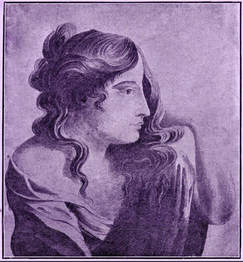 Emma Lady Hamilton (1765 – 1815) - earliest amateur sketch by Miss Thomas (daughter of her first employer) at Hawarden. Emma Lady Hamilton (1765 – 1815) - earliest amateur sketch by Miss Thomas (daughter of her first employer) at Hawarden. The first known portrait of Emma, Lady Hamilton was sketched by the daughter of a local doctor in Hawarden, Wales, when Emma was 12 years old. The little subject would become possibly the most sketched woman of her time. Paintings of Emma document her journey through the stages of nurse-maid, domestic mistress, famed ambassadress and to the notorious whore she would become. Hers would become a life recorded through portraiture. 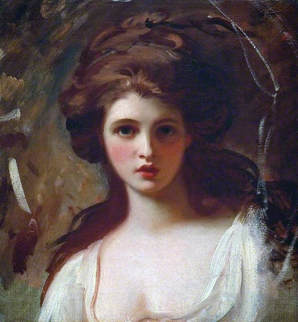 Emma as Circe, by George Romney, 1782 Emma as Circe, by George Romney, 1782 Undoubtedly the most well remembered scandal of Georgian England was the devoted alliance between Emma, Lady Hamilton and the hero of the nation, Horatio Nelson. Like any public and unconventional woman, an inordinate amount has been written about Lady Hamilton, much of it unflattering and most of it untrue. The daughter of a blacksmith Emma, born Emy Lyon in Cheshire in 1765, was at the age of sixteen or seventeen a most ravishingly beautiful girl who had become the full time mistress of the Hon. Charles Greville, after her first wealthy protector, Sir Harry Fetherstonehaugh had tired of her during her pregnancy with his child. Greville took her and her widowed mother Mrs Cadogan into his care after her daughter was born and took a house for them on Edgware Row in Paddington Green. Emy Lyon thereafter went by the more upwardly mobile name of Mrs Emma Hart. Before her time with Fetherstonehaugh and Greville as a domestic mistress, Emy held places as a nursemaid in two or three private houses. Her daughter by Fetherstonehaugh, Emma Carew, was brought up by her grandmother in Wales. 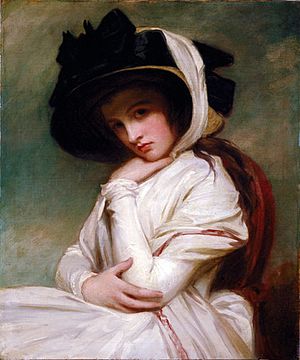 Emma Hamilton as a young girl (aged seventeen) c. 1782, by George Romney Emma Hamilton as a young girl (aged seventeen) c. 1782, by George Romney During the five years she lived with Greville, Emma sat more than 100 times for the painter George Romney. Though many these sittings were by Romney’s desire, Emma was his ultimate muse, many of them were commissioned by Greville and it was the cost of these portraits, along with his obsession for collecting mineral specimens, that helped contribute to the massive personal debts that moved Greville to give Emma up in 1786 in search of a wealthy bride. Greville sent her to Naples to be the guest of his uncle Sir William Hamilton, the British Envoy to Naples, with the expressed plan of following her shortly. Hamilton, who was also a scholar, author and vulcanologist, a leading antiquarian and art collector, knew Emma from a long visit to England in 1783, during which he socialized much with his nephew and nicknamed Emma ‘the fair teamaker of Edgware Row’. Greville intended to remain in England and marry an heiress, and that the warm, charismatic presence and lovely Grecian beauty of Emma would move the already fond Sir William to keep her himself. If such a relationship were formed, then no children could disinherit Greville of Hamilton’s fortune, as said children would be illegitimate. After months of waiting faithfully for Greville, the reality of her situation dawned on her and Emma formed a relationship with Sir William, whom she admired and grew to love, and as such she was educated and ‘finished’, the benefits of elocution, foreign language and singing lessons added to her natural graces, and in 1791 he married her. 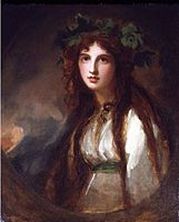 Emma as a Bacchante by George Romney, 18th century Emma as a Bacchante by George Romney, 18th century As Lady Hamilton, Emma was quite literally the toast of Naples society. She was a great favourite at the Neapolitan court of Kind Ferdinand IV and the close friend and confident of the Queen, Maria Carolina (sister of Marie Antoinette of France). In Naples she developed her Attitudes, a repetoire of tableaux vivant poses representing classical characters from Ancient Greek and Roman history, that became famous and much admired in Europe by many, including writer Johann Wolfgang Goethe and composer Joseph Hadyn, other artists and academics and many of the members of parliament, of royal families and of aristocracies within Sir William’s vast and varied ambassadorial, artistic and academic circles. Though Emma indeed was very beautiful, it was the way she could embody a character as an ideal and her eye for the visually artistic, the skills of a good model and a muse, that made her prized by many painters as a subject, including Vigée le Brun, Marie Antoinette’s friend and principal portrait artist. The Neoclassicism of the Enlightenment and the European Republican admiration for Ancient Greece and Rome were the driving forces behind the radical change of dress in the Georgian period and the simple, classical, Grecian costumes of Lady Hamilton’s Attitudes were highly influential on the Directoire and Empire styles of women’s dress in Europe and Britain. 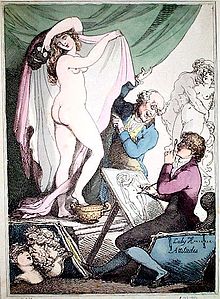 Emma performing the "Attitudes", caricatured by Thomas Rowlandson Emma performing the "Attitudes", caricatured by Thomas Rowlandson Emma first met Admiral Nelson briefly in August 1793 when he docked in the Bay of Naples so that he and Sir William could forge a treaty with King Ferninand but it was not until he returned after five years of war in 1798 that their unique relationship was solidified. The bond between Sir William, Emma and Nelson was complicated and highly nuanced. A frail, injured and battle-weary Nelson was nursed back to health and joyfulness by Emma. First as his nursemaid, with the skills and patience she’d learned in her pre-courtesan career and then as his mistress, Emma nurtured and worshiped Nelson who was, at the same time, treated as a son and friend by Sir William. For the next 18 months, Nelson, who was childless but unhappily married to a wife in England, Lady Frances, lived with the Hamiltons. 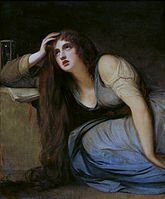 Lady Hamilton as The Magdalene, by George Romney, before 1792 Lady Hamilton as The Magdalene, by George Romney, before 1792 In 1800 the Hamiltons and Nelson returned to England, where society was far less forgiving and where Nelson, his wife Lady Frances and his family the Nelsons were adored, and where Emma was despised and ridiculed in the press. Nelson spent some time with Lady Nelson at first but soon gave up the charade entirely and, between naval engagements, he was most often a guest in Sir William’s house in London and openly conducted his relationship with Emma. The affair was an outrageous scandal, sympathy and solidarity for the abandoned and blameless Lady Nelson was intense and Emma, though the wife of the highly respected Neapolitan ambassador, was denied presentation at court and duly shunned by ‘good’ society. But she was believed to have become a friend of the Prince Regent, naturally. In 1801 while in the late stages of pregnancy, she still went abroad in London, defying the accepted practice of gentlewomen to not socialize at large once they had began to show, and to remain confined entirely to their homes in late pregnancy. She was consequently lampooned in the press as hugely obese and, despite her education, charm and grace, as vulgar and irredeemably working class. 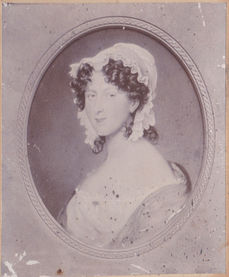 Horatia Ward née Nelson Horatia Ward née Nelson Their daughter Horatia was born in 1801. Sir William, quite elderly by this time, died in London in 1803 and Nelson purchased a house for Emma at Merton but he himself was assigned to the HMS Victory and would not return to England for two years. Their second child Emma was born not long after his departure and died early of chicken pox. Upon his return , he and Emma lived happily for a few short months as husband and wife at Merton before he was recalled to the war. Horatio Nelson was killed in action at the Battle of Trafalgar in 1805. In his will, Nelson entrusted Emma’s care to the nation, as his estate must fall to his brother, but this request was ignored by George III and his government. With her working class roots, courtesan background and her adulterous connection to the nation’s hero, Emma Hamilton was an embarrassment. Struggling to keep up Merton as a monument to England’s beloved Nelson, she swiftly burned through all she had within three years and after borrowing money she couldn’t repay, she spent a year with Horatia in King’s Bench debtor’s prison, where the Prince Regent dined with her on occasion. She then left England permanently for France. Lady Hamilton died destitute of alcoholism ten years later in Calais in 1815, her first daughter Emma Carew is believed to have died without issue, abroad or in Wales not long after her mother. Horatia Nelson was taken in by Nelson’s mother’s relations and later married the Reverend Phillip Ward at the age of 21. They were by all accounts a very happy couple and had ten children together, eight of whom survived to adulthood and whose descents still live in Norfolk. I sometimes wonder if the very public and well publicized scandal of Emma and Nelson had an impact on the way Austen chose to portray the navy and sexual misconduct in Mansfield Park.
2 Comments
Corrine Streetly
1/17/2018 03:36:45 am
Interesting and well written article, at least I think so.. I own a small original monotype (?) of Emma Hamilton, inherited from my Grandmother.
Reply
Leave a Reply. |
Sex History ContentsIf you would like to submit an article, please fill out a submission on the Contact page Archives
September 2020
|
 RSS Feed
RSS Feed